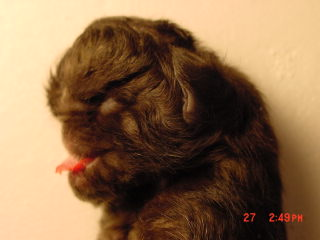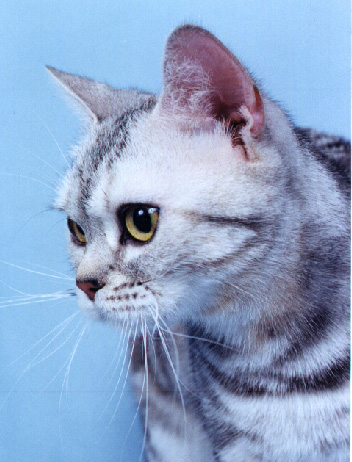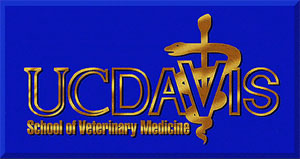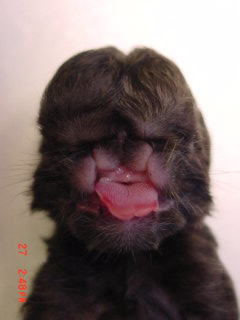|
|
Background
The development of animal breeds is
accomplished by repeatedly breeding individuals with particular traits
of interest. Along with traits of beauty and behavior, most all
mammalian species harbor many recessive traits that are deleterious to
the species. Two copies of these traits need to be present in order for
the "disease" or "defect" to be expressed. Breed
development, strong inbreeding and line breeding makes beautiful breeds
with highly desired traits, but problem genes can occassionally and
accidently become increased in frequency. Unfortunately, an
unforeseeable, and undesirable trait has reached a high level in groups
of the Burmese and other breeds, which could not be predicted in advance
by any breeder. The undesirable trait is known
as the "Head Defect".
During the 1970's, a alternative
style Burmese cat was established. Phenotypically still within the
CFA standard (4), this "strain" of Burmese expresses a
more rounded head with a higher frontal prominence, a shorter,
broader muzzle, seeming larger and more prominent eyes, and
generally a more demarcated nose break. This shorter, broader
muzzle form has been referred to as the "Eastern",
"new look", "Contemporary", or "more
extreme". The longer, narrower muzzle form is referred to as
"Traditional" or "less extreme".
The "more extreme"
Burmese quickly became popular in the show ring and intensive
breeding programs ensued. Shortly after the widespread
establishment of the "more extreme" cats, litters
involving the "more extreme" cats as both parents began
to produce kittens with a severe congenital craniofacial
deformity.
The association of the
craniofacial deformity with the "more extreme" phenotype
of the Burmese has raised a severe dichotomy amongst the Burmese
breeders and a rift within fancy cat breeding societies.
Conflicting results of the initial investigations, concerns of
accuracy, confidentiality, and inaccurate interpretations has
posed the question as to whether the "more extreme"
phenotype should be propagated, and to whether "more
extreme" phenotypes can be maintained without the deformity.
As a result, the National Alliance of Burmese Breeders (NABB), a
solely "more extreme" Burmese breeding group, initiated
a request for proposals through the Winn Feline Health Foundation
for the "Study of Craniofacial Malformations Occurring in
Burmese Cats". Dr. Lyons responded to this request and is
continuing research on the Head Defect, which is also found in
other breeds, such as Bombay and American Shorthairs.
Go
to top
Genetics
An investigation of the defect by
Zook et. al (5), provided a detailed clinical description of the
defect as well as a suggestion that the deformity may elicit an
autosomal recessive mode of inheritance. By 1983, over 90 purebred
Burmese from a disperse group of catteries had been afflicted with
the deformity. No obvious infections, toxic agents or
environmental conditions could be correlated with the deformity.
The common genealogy of the cats producing the deformity in their
litters revealed cats of common ancestry that had been extremely
proliferative, including a line of show-winning cats that had been
extensively bred.
A research cooperative was
established to investigate causation and the mode of inheritance
of the craniofacial deformity (6). The cooperative was known as
The Burmese Cooperative Research Project, and a cattery,
Searchcore, was established to oversee the test breedings for the
project. Under the assumption of a recessive mode of inheritance,
Searchcore established matings between known carriers (all
"more extreme") and non-carriers and/or cats of unknown
status (both of the "less extreme" phenotype). The
kittens of the resulting litters were then bred to known carrier
cats, which all were of the "more extreme" phenotype.
The 33 second generation matings produced 151 kittens of which 20
expressed the craniofacial deformity. The interpretations of the
test matings and data collected from 46 questionnaires to breeders
were made. Frances O. Smith, D.V.M., of the University of
Minnesota, was enlisted by the Searchcore to interpret the
pedigree analysis. Dr. Smith suggested an incomplete dominant mode
of inheritance and that the deformity was a result of the
"more extreme" phenotype (6). Deformed kittens being
homozygous and the heterozygous form to be expressed as the
"more extreme" phenotypic cats.
The inheritance pattern was
informally addressed by Sponenberg and Graf-Webster in 1986 (9).
Of 22 litters born to matings between Burmese parents which
previously had produced the craniofacial defect, 19 of 88 kittens
expressed the deformity. The 69:19 ratio did not deviate
significantly from an autosomal recessive mode of inheritance (X2
= 0.545) at the 95% confidence interval. The gene symbol, mc, was
suggested by Dr. Roy Robinson to represent the
meningoencephalocele syndrome (2,9).
Breeders often have litters that
have several defective kittens or also notice that a particular
mating has many defective kittens. The defect is recessive, thus
breeders must realize that over all matings, the defect should be
seen about 25%. Some carrier to carrier matings may not produce
any defective kittens, and breeders may fail to realize that these
kittens should be counted in the overall average. Each kitten has
a 25% chance of being defective when both parents are carriers.
Each kitten in a litter is independent of its littermates! The
chances of getting 4 affected kittens in a litter of four is
exactly the same as getting zero kittens affected.
Go
to top
Breeds
The head deformity originated in
Burmese cats in the USA. The defect has been seen in England and
Europe due to the importation of the "more extreme"
Burmese cats from the USA. Any breed that uses a "more
extreme" Burmese has a potential of acquiring the recessive
gene. The defect is then likely to reappear when two carriers are
bred. Bombay's do have the head defect gene as do some lines of
American Shorthairs. Thus, Bombays and some American Shorthairs
can now also spread the gene that causes the defect. The
introduction of the head defect is accidental and is difficult to
predict.
Clinical Presentation
Searchcore also established a
collaboration with Cornell University to investigate the
developmental mechanism of the deformity (7). Over 40 of the
deformed kittens were examined. The defect was originally
described as either maxillonasal hypoplasia (5) or incomplete
diprosopus (8). The Cornell study initially suggested a mechanism
of transformation of the medial nasal part of the frontonasal
process, naming the defect: telencephalic
meningohydroencephalocele. This defect was also referred to as:
Incomplete conjoined twinning, by the Cornell group. This group
restated Dr. Smith's interpretation that the "more
extreme" phenotype is a less severe expression of the
deformity, and some homozygotes cross a threshold which results in
the lethal malformation.
The Burmese Head Defect presents
at birth. The area of the upper jaw is duplicated and two hard
palates and two sets of whisker pads can be easily seen. The head
region above the upper jaw does not form properly. Eyes and ears
are malformed and there is not complete closure of the skull. The
brain appears to be protruding from the skull but it is generally
covered by skin that may or may not be covered with fur. Kittens
can be born alive and should be humanely euthanized.
|
|
 |
| Frontal View |
Side view |
| Cranial-Facial Abnormality |
|
Carol W. Johnson, DVM, PhD is a
board certified pathologist and has studied many of the deformed
cats and the carriers in the American Shorthair breed. The head
defect presents as the same condition in the American Shorthairs
as in the Burmese. The "more extreme" facial structure
is also seen in the American Shorthairs as in Burmese, but clearly
defining the carriers remains difficult when just based on nose
break and the preferred facial qualities. Other presentations are
also common between Burmese and American Shorthairs, particularly
dermoids in the nose area. Eyelid colobomas and cleft lips have
also been noted in the American Shorthairs. A minor longitudinal
depression along the midline of the nose, which may or may not be
palpable, has been noticed in nearly 90% of the cats that are
carriers in American Shorthairs. This hallmark would be more
difficult to identify in Burmese and Bombays since they are solid
and darkly colored cats. It should be noted that the midline nose
depression may not be a 100% correlation with carriers. Some known
carriers do not have the variation, and it is possible that
somecats may have this depression and not actually carry the
defect. These various indicators of carriers should be combined
with pedigree analyses to help determine of cats potentially
carrier the defect.
| |
|
|
|
|
| Dermoids |
Eyelid coloboma |
Cleft lip |
Midline color variation |
|
Go
to top
Clinical Management
The deformity is not compatible
with life thus kittens need to be humanely euthanized if not
stillborn. Unfortunately, the only resort for a breeder is to
attempt to not breed two carrier cats in a particular mating. To
test a cat, a known carrier needs to be bred to theunknown cat.
Known carriers are cats that have produced defective kittens. But
unfortunately, this defect is recessive, thus only 1 in 4 kittens
(on average) will present with the defect. These test crosses need
to produce at least 12 non-defect kittens from the same matings to
be 95% confident that a unknown cat is not a carrier. And the
breeder must be aware that since one parent is a known carrier
during a test cross, then each kitten produced from test crosses
has at least a 50% chance of being a carrier.
Gene Hunting and Current Research
The Comparative Genetics
Laboratory of Dr. Leslie Lyons at the School of Veterinary
Medicine at UCDavis is currently searching for a marker and the
gene causing the Head Defect. Dr. Lyons has interacted with the
Burmese and Bombay breeding communities for many years to
collected the necessary samples for the project and is now working
with American Shorthair breeders also. Additionally, Dr. Lyons
laboratory also develops feline genetic tools and resources that
will assist the project. These tools include genetic maps and DNA
libraries for the cat.
History of Dr. Lyons' Research
The first proposal by Dr. Lyons
was in response to the request of the NABB. The project proposed a
combination of a prospective and retrospective study to
investigate the genetics of the craniofacial deformity expressed
in a portion of Burmese cats. After reviewing the previous studies
and the limited available data, and determining that a single gene
was highly likely to be responsible for the defect, it was decided
that a beneficial study could be initiated. The project had four
goals: 1) formally verify the mode of inheritance of the
craniofacial defect and formally address the mode of inheritance
of the Burmese facial morphology, 2) establish genetic linkage or
non-linkage between the craniofacial defect and facial morphology
in formal pedigree analysis of existing and proposed pedigrees, 3)
test a panel of high resolution polymorphic genomic markers,
feline microsatellite loci, for linkage to the craniofacial
deformity and Burmese facial morphology, 4) provide suggestions
for the eradication of the deformity from the Burmese breed.
Results from this study
suggested:
1) The defect is caused by two
copies of the mutated gene and is autosomal recessive. Pedigree
analyses from cats that were imported into France were very
helpful with clarifying the confusion.
2) The "more extreme"
facial structure is strongly associated with the defect, but no
strict "threshold" could be determined. Breeders should
realize that not all short facial structures are due to this gene.
For example, Persians have very short facial structures, but do
not have a problem with this defect. In addition, many
"Traditional" Burmese breeders have successfully
produced cats that have shorter facial structures that are not a
result of contemporary breedings but due to selection of cats with
the preferred type. The cats were both from Traditional breedings
and crosses with imported cats from Thailand. Although a longer
process, good selection can produce competitive show cats.
3) Genetic markers were tested in
the Burmese cats and they were found to have sufficient genetic
variation for gene mapping studies. Many breeds of animals have
problems with inbreeding and low genetic variaiton. Low genetic
variation also makes it difficult to find markers for genes of
interest. Hence, the analysis of different breeds of cats,
Burmese, Bombays and American Shorthairs, is actually very
beneficial for identifying genetic markers.
4)Counselling for breeders is
very important for this problem. Breeders need to slowly eliminate
the known carriers from their programs. Importantly, breeders must
realize that although a cat may carry this defect, any given cat
may have many other attributes that are important to the breed and
a cattery. Thus, although some breeders have the ability to
eliminate the questionable lines, other breeders may not have the
luxury to be as aggressive. Breeders should be tolerant and
cooperative with the decisions that need to be made for a
particular cattery. Without a definitive test, like a genetic
marker, carriers will go undetected, even with the most aggressive
culling.
UCDavis
Winn Foundation Proposal (Feb. 2002 - Jan. 2004)
2 years,
$30,000.00 with $20,000.00 match from UCD Center for Companion
Animal Health and $20,000.00 match from Dr. Lyons research
program.
Grant Proposal to National Institute for
Dental and Craniofacial Research (NIDCR) (Jan. 2003 - Dec. 2004)
2 years, $100,000.00
NIDCR Program Announcement 1
NIDCR Program Announcement 2
Go
to top
Join the Project!
There are many ways for breeders
to participate. If you have a litter with a defective kitten, the
project can use that individual kitten. Additionally, samples from
the relatives are very helpful. Thus, a breeder can help by
providing a sample from a cat that is a relative, but they have
never had a defective kitten. Breeders can also help to spread the
information and encourage other breeders to participate. The
project will be more successful with greater enthusiasm from the
breeders.
Breeders need to supply samples:
a. defective kitten cadavers
b. blood samples from siblings
c. blood samples from parents
d. blood samples from
grandparents
Ideally, all these samples can be
obtained from each litter that has a defective kitten, but some
missing samples can be tolerated.
FAQ: Frequently asked Questions
Is the defect recessive or
incompletely dominant?
Confusion results from which
trait is being discussed. In order to produce defective kittens, 2
copies of the mutated gene are required. The defect is recessive.
But, the "more extreme" presentation of the face is more
complex. Most genes that affect structure are influenced by
environment and other "background" genes. When breeders
use a "more extreme" Burmese, the shorter face is more
dominant, but variation is seen. Thus, the inheritance of the
"more extreme" facial structure is incompletely
dominant. So far, we can not predict which of the "more
extreme" cats carrier the head defect. Other mild defects and
abnormalities provide some clues, such as the dermoids and the
color variation on the midline of the nose, but they are not 100%
accurate or 100% predictive. Once the gene is identified, perhaps
we will be able to make facial measurements that will help
identify these cats, but a DNA test will be far more accurate.
How can the disease be recessive
when I had all my kittens affected?
Breeders do not immediately know
which cats are carriers. When 2 carrier cats are bred, 25% (1 in
4) of the kittens should have the defect. But this is an overall
average. Breeders will not recognize that cats are carriers if
they have a litter that has no affected kittens, hence breeders
often miss this litters amd they are not counted to create the
overall average. Cats will not "throw" the defect more
or less often, it is all a game of luck and averages.
How can we get rid of the
problem?
At this time, the only thing
breeders can do is learn about the defect and the lines that
potential carry the defect. Two carriers should not be bred
together if possible. If a cat is identified as a carrier, is
could be eliminated from a breeding program if there are options
to not use that cat. Breeders want to be careful to not destroy
complete breeding programs and reducing the numbers of Burmese
used to quickly. This could cause other inbreeding problems! There
are lots of other good qualities in these cats!
What cat caused this problem?
This question is likely to very
quickly cause animosity amongst the breeding community and will
quickly stop a project in its tracts. Although pedigree
examinations can generally identify an individual cat, this
process tends to cause fractionation amongst breeders. Breeders
need to realize that it is no longer important which cat may have
been the originator of the problem. Every offspring produced from
the initial cat has a 50% chance of being a carrier. Without a
carrier test, each cat produced and the subsequent offspring have
a chance of propagating the problem. The elimination of all these
cats would cause a big lose of cats in the breed, and may cause
more inbreeding problems. The defect is caused by one problem
gene, but the same Burmese cats may have many excellent qualities
that are needed within a breed. Additionally, the elimination of
all suspect cats could greatly damage some breeding programs,
which is NOT the goal of the research and hopefully not the goal
of the cat community. Breeders should focus on presently known
carriers and either not breeding these cats to other carriers, or
not breeding the carriers at all.
References
1. Thompson J et al: Genetics of
the Burmese cat. Heredity 34, 1943
2. Robinson R: Genetics for Cat
Breeders. 3rd Ed. Pergamon Press, Oxford, 1991.
4. Show Standards: The Cat
Fanciers' Association, Inc. May 1,1993-April 30, 1994.
5. Zook BC et al:Encephalocele
and other congenital craniofacial anomalies in Burmese cats. Vet
Med/Small Anim Clin 78:695-701, 1983.
6. Searchcore: Report of the
Burmese Research Group. June 14, 1984.
7. Noden DM and Evans HE:
Inherited homeotic midfacial malformations in Burmese cats. J
Craniofacial Genet Devel Bio (Suppl) 2:249-266, 1986.
8. Sekeles, E: Craniofacial and
skeletal malformaitons in a cat. Feline Prac 11:28-31, 1981.
9. Sponenberg DP and Graf-Webster
E: Heredity meningoencephalocele in Burmese cats. J Hered 77:60,
1986.
Go
to top
Please provide suggestions to the
webmaster:mailto:felinegenome@ucdavis.edu
|
| |
|
|





